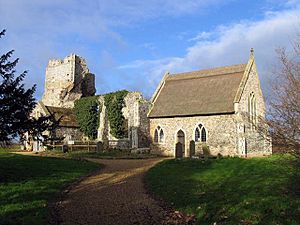All Saints' Church, Billockby facts for kids
Quick facts for kids Church of All Saints, Billockby |
|
|---|---|

The church in 2007
|
|
| 52°39′56″N 1°35′31″E / 52.66556°N 1.59194°E | |
| OS grid reference | TG 430 136 |
| Location | Near Fleggburgh, Norfolk |
| Country | England |
| Denomination | Church of England |
| Architecture | |
| Heritage designation | Grade II |
| Designated | 25 September 1962 |
| Style | Perpendicular |
| Administration | |
| Diocese | Diocese of Norwich |
All Saints' Church is an old Anglican church located near the villages of Billockby and Fleggburgh in Norfolk, England. Part of the church is in ruins, but it is still a special place. It is recognized as a Grade II listed building, which means it is an important historical site.
The front entrance (porch) and the main altar area (chancel) of the church are still used regularly. Church services happen at 9 AM on the fourth Sunday of each month. These services take place from Easter until September.
Contents
History of All Saints' Church
Building the Church
This church was first built a very long time ago, in the 15th century. That means it is over 500 years old! The church was built in a style called Perpendicular. This style was popular in England during the late Middle Ages. It is known for its tall, slender pillars and large windows.
The Great Storm of 1762
Sadly, a big storm hit the church on July 15, 1762. During this storm, the roof of the main part of the church (the nave) fell down. Because of this, the nave and the church tower are now in ruins. These parts were also built in the Perpendicular style.
The walls of the nave were made from a material called "knapped flint." This is a type of stone that has been carefully shaped. The nave also had large windows. You can still see parts of their beautiful stone patterns, called "tracery."
The Chancel and Its Use
Even after the storm, the chancel, which is the part of the church where the altar is, was still in use in 1762. It was repaired and made new again in 1872. Today, the chancel is still used regularly for services.
The chancel walls are also made of flint. They have smooth, cut stone pieces called "ashlar" around the edges. The roof of the chancel is covered with thatch, which is a traditional roofing material made from straw or reeds. Inside the chancel, there is a special octagonal (eight-sided) font. This font was also made in the 15th century and is used for baptisms.

